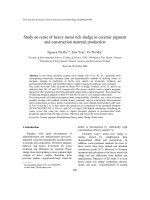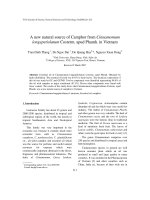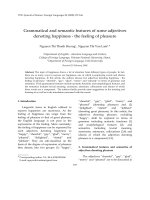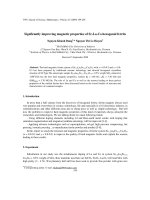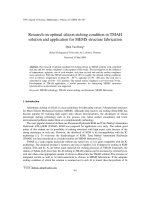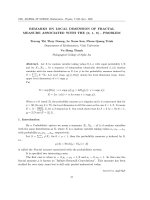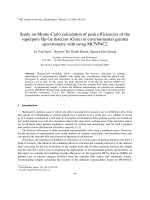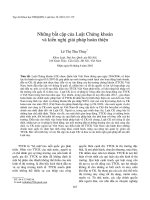Tài liệu Báo cáo "REMARKS ON LOCAL DIMENSION OF FRACTAL MEASURE ASSOCIATED WITH THE (0, 1, 9) - PROBLEM " pdf
Bạn đang xem bản rút gọn của tài liệu. Xem và tải ngay bản đầy đủ của tài liệu tại đây (242.46 KB, 18 trang )
VNU. JOURNAL OF SCIENCE, Mathematics - Physics. T.XXI, N
0
3 - 2005
REMARKS ON LOCAL DIMENSION OF FRACTAL
MEASURE ASSOCIATED WITH THE (0, 1, 9) - PROBLEM
Truong Thi Thuy Duong, Le Xuan Son, Pham Quang Trinh
Department of Mathematics, Vinh University
Vu Hong Thanh
Pedagogical College of Nghe An
Abstract.
Let X be random variable taking values 0, 1,a with equal probability 1/3
and let X
1
,X
2
, be a sequence of independent identically distributed (i.i.d) random
variables with the same distribution as X. Let
µ be the probability measure induced by
S =
∞
i=1
3
−i
X
i
.Letα(s) (resp. α(s), α(s)) denote the local dimension (resp. lower,
upper local dimension) of
s ∈ supp µ.
Put
α =sup{α(s):s ∈ supp µ}; α =inf{α(s):s ∈ supp µ};
E = {α : α(s)=α
for some s ∈ supp µ}.
When a ≡ 0(mod3), the probability measure µ is singular and it is conjectured that for
a =3k (for any k ∈ N), the local dimension is still the same as the case k =1, 2.Itmeans
E =[1−
log(a)
b log 3
, 1],fora, b depend on k. Our result shows that for k =3(a =9), α =1,
α =2/3 and E =[
2
3
, 1].
1. Introduction
By a Probabilistic system we mean a sequence X
1
,X
2
, of i.i.d random variables
with the same distribution as X, where X is a random variable taking values a
1
,a
2
, ,a
m
with probability p
1
,p
2
, ,p
m
, respectively.
Let S =
∞
i=1
ρ
i
X
i
,for0< ρ < 1, then the probability measure µ induced by S,
i.e.,
µ(A)=Prob{ω : S(ω) ∈ A}
is called the Fractal measure associated with the probabilistic system.
It is specified two interesting cases.
The first case is when m =2,p
1
= p
2
=1/2anda
1
=0,a
2
=1. Inthiscasethe
fractal measure µ is known as ”Infinite Bernoulli Convolutions”. This measure has been
studied for over sixty years but is still only partial understood today.
Typeset by A
M
S-T
E
X
33
34Truong Thi Thuy Duong, Le Xuan Son, Pham Quang Trinh, Vu Hong Thanh
The second case of interest is when m =3, ρ = p
1
= p
2
= p
3
=1/3anda
1
=0,a
2
=
1,a
3
= a. Some authors have found α, α and E for some concrete values of a for which
µ is singular. But for each of them, the way to find
α, α and E is quite different. It is
conjectured that the way to find them in the general case is dificult.
Let us recall that for s ∈ supp µ the local dimension α(s)ofµ at s is defined by
α(s) = lim
h→0
+
log µ(B
h
(s))
log h
, (1)
provided that the limit exists, where B
h
(s) denotes the ball centered at s with radius h.If
the limit (1) does not exist, we define the upper and lower local dimension, denoted
α(s)
and α
(s), by taking the upper and lower limits, respectively.
Denote
α =sup{α(s):s ∈ supp µ} ; α =inf{α(s):s ∈ supp µ},
and let
E = {α : α(s)=α for some s ∈ supp µ}
be the attainable values of α(s), i.e., the range of function α definning in the supp µ.
In this paper, we consider the interest second case with a =9(a ≡ 0 (mod 3)).
Our result is the following.
Main Theorem. For a =9,
α =1, α =
2
3
and E =[
2
3
, 1].
The paper is organized as follows. In Section 2, we establish some auxiliary results
are used to prove the formula for calculating the local dimension. In Section 3, we prove
the maximal sequences, it is used to find the lower local dimension. The proof of the Main
Theorem will be given in the last section.
2. The formula for calculating the local dimension
Let X
1
,X
2
, be a sequence of i.i.d random variables each taking values 0, 1, 9
with equal probability 1/3. Let S =
∞
i=1
3
−i
X
i
, S
n
=
n
i=1
3
−i
X
i
be the n-partial sum
of S, and let µ, µ
n
be the probability measures induced by S, S
n
, respectively. For any
s =
∞
i=1
3
−i
x
i
∈ supp µ, x
i
∈ D: = {0, 1, 9},lets
n
=
n
i=1
3
−i
x
i
be its n-partial sum.
Let
s
n
= {(x
1
,x
2
, , x
n
) ∈ D
n
:
n
3
i=1
3
−i
x
i
= s
n
}.
Then we have
µ
n
(s
n
)=#s
n
3
−n
for every n, (2)
where #X denotes the cardinality of set X.
Two sequences (x
1
,x
2
, , x
n
)and(x
1
,x
2
, , x
n
)inD
n
are said to be equivalent,
denoted by (x
1
,x
2
, ,x
n
) ≈ (x
1
,x
2
, ,x
n
)if
n
i=1
3
−i
x
i
=
n
i=1
3
−i
x
i
.Wehave
Remarks on local dimension of fractal measure associated with 35
2.1. Claim. (i) For any (x
1
,x
2
, ,x
n
), (x
1
,x
2
, ,x
n
)inD
n
and s
n
=
n
i=1
3
−i
x
i
,
s
n
=
n
i=1
3
−i
x
i
,wehave|s
n
− s
n
| = k3
−n
for some k ∈ N and x
n
− x
n
≡ k (mod 3).
(ii) Let s
n
<s
n
<s
n
be three arbitrary consecutive points in supp µ
n
.Theneithers
n
−s
n
or s
n
− s
n
is not
i
3
n
for i =1, 2, 3andforeveryn ∈ N.
(iii) Let s
n
,s
n
∈ supp µ
n
and s
n
− s
n
=
1
3
n
or
4
3
n
.Thens
n
= s
n−1
+
1
3
n
is the unique
representation of s
n
through points in supp µ
n−1
and s
n
= s
n−1
+
0
3
n
or s
n
= s
n−1
+
9
3
n
or both of them, where s
n−1
,s
n−1
in supp µ
n−1
.
(iv) For any s
n
,s
n
∈ supp µ
n
such that s
n
− s
n
=
2
3
n
.Thens
n
= s
n−1
+
1
3
n
is the unique
representation of s
n
through points in supp µ
n−1
and s
n
= s
n−1
+
0
3
n
or s
n
= s
n−1
+
9
3
n
or both of them, where s
n−1
,s
n−1
,s
n−1
in supp µ
n−1
.
Proof. It is proved similarly as proof of Claim 2.1, 2.2 in [11].
2.2. Corollary. (i) Let s
n+1
∈ supp µ
n+1
and s
n+1
= s
n
+
1
3
n+1
,s
n
∈ supp µ
n
.Wehave
#s
n+1
=#s
n
, for every n 1.
(ii) For any s
n
,s
n
∈ supp µ
n
, if s
n
− s
n
=
1
3
n
or s
n
− s
n
=
2
3
n
,thens
n
,s
n
are two
consecutive points in supp µ
n
.
(iii) Let s
n
,s
n
∈ supp µ
n
, if s
n
− s
n
=
1
3
n
then #s
n
a #s
n
.
Proof. It follows directly from Claim 2.1.
2.3. Lemma. For any s
n
,s
n
∈ supp µ
n
, if s
n
− s
n
=
3
3
n
, then either both of s
n
,s
n
have
two representations through points in supp µ
n−1
or s
n
= s
n−1
+
x
n
3
n
,s
n
= s
n−1
+
x
n
3
n
,for
x
n
∈ D, s
n−1
,s
n−1
in supp µ
n−1
.
Proof. Assume on the contrary, then there are the following cases.
Case 1. If s
n
= s
n−1
+
0
3
n
= s
n−1
+
9
3
n
,s
n
= s
n−1
+
0
3
n
(1).
Then s
n−1
−s
n−1
=
2
3
n−1
. By Claim 2.1 (iv) s
n−1
= s
n−2
+
1
3
n−1
.Itimpliess
n
= s
∗
n−1
+
9
3
n
,
where s
∗
n−1
= s
n−2
+
0
3
n−1
,acontradictionto(1).
Case 2. If s
n
= s
n−1
+
0
3
n
= s
n−1
+
9
3
n
,s
n
= s
n−1
+
9
3
n
(2).
Then s
n−1
−s
n−1
=
4
3
n−1
. By Claim 2.1 (iii) s
n−1
= s
n−2
+
1
3
n−1
. It implies s
n
= s
∗
n−1
+
0
3
n
,
where s
∗
n−1
= s
n−2
+
0
3
n−1
,acontradictionto(2).
Case 3. If s
n
= s
n−1
+
9
3
n
,s
n
= s
n−1
+
0
3
n
= s
n−1
+
9
3
n
(3).
Then s
n−1
−s
n−1
=
1
3
n−1
. By Claim 2.1 (iii) s
n−1
= s
n−2
+
1
3
n−1
.Ifs
n−1
= s
n−2
+
0
3
n
,then
s
n
= s
∗
n−1
+
0
3
n
,wheres
∗
n−1
= s
n−2
+
1
3
n−1
, a contradiction to (3). Hence s
n−1
= s
n−2
+
9
3
n
.
It implies s
n−2
− s
n−2
=
2
3
n−2
.
If s
n−2
= s
n−3
+
0
3
n−2
,thenthereiss
n−2
= s
n−3
+
1
3
n−1
. Hence s
n−2
= s
n−3
+
9
3
n−2
.
Thus, by repeating this argument then there are two points s
1
,s
1
∈ supp µ
1
, such that
s
1
− s
1
=
2
3
,acontradiction.
Case 4. If s
n
= s
n−1
+
0
3
n
,s
n
= s
n−1
+
0
3
n
= s
n−1
+
9
3
n
(4).
36Truong Thi Thuy Duong, Le Xuan Son, Pham Quang Trinh, Vu Hong Thanh
Then s
n−1
−s
n−1
=
4
3
n−1
. By Claim 2.1 (iii) s
n−1
= s
n−2
+
1
3
n−1
.Ifs
n−1
= s
n−2
+
0
3
n
,then
s
n
= s
∗
n−1
+
9
3
n
,wheres
∗
n−1
= s
n−2
+
1
3
n−1
, a contradiction to (4). Hence s
n−1
= s
n−2
+
9
3
n
is the unique representation of s
n−1
(5). Then we have s
n−2
− s
n−2
=
4
3
n−2
,byClaim2.1
(iii) s
n−2
= s
n−3
+
1
3
n−2
. Then there is s
n−2
= s
n−3
+
0
3
n−1
.Itimpliess
n−1
= s
n−2
+
0
3
n
a contradiction to (5). So this case does not happen.
Observe that, from Case 3 and Case 4 there are not the cases
s
n
= s
n−1
+
9
3
n
,s
n
= s
n−1
+
0
3
n
and
s
n
= s
n−1
+
0
3
n
,s
n
= s
n−1
+
9
3
n
.
The lemma is proved.
2.4. Corollary. (i) Let s
n
,s
n
∈ supp µ
n
, if s
n
− s
n
=
3
3
n
, then #s
n
a #s
n
.
(ii) For any s
n
<s
n
<s
n
are three consecutive points in supp µ
n
and s
n
− s
n
=
3
3
n
,
then
s
n
− s
n
=
2
3
n
.
Proof. (i) It follows directly from Lemma 2.3 and Corollary 2.2(iii).
(ii) It follows directly from Lemma 2.3 and Claim 2.1 (ii).
2.5. Lemma. Let s
n
,s
n
∈ supp µ
n
, if s
n
− s
n
=
1
3
n
,
then
µ
n
(s
n
)
µ
n
(s
n
)
a
n +1
2
.
Proof. We will prove the inequality by induction. Clearly the inequality holds for n =1.
Suppose that it is true for all n a k − 1. We consider the case n = k.
By Claim 2.1 (iii) and Corollary 2.2 (i), we have #s
k
=#s
k−1
,where
s
k
= s
k−1
+
1
3
k
,s
k−1
∈ supp µ
k−1
.
We consider the following cases.
Case 1. If s
k
= s
k−1
+
0
3
k
is the unique representation of s
k
through point in supp
µ
k−1
. Then #s
k
=#s
k−1
. Therefore
#s
k
#s
k
=
#s
k−1
#s
k−1
=1a
k +1
2
.
Case 2. If s
k
has two representations through points in supp µ
k−1
,
s
k
= s
k−1
+
0
3
k
= s
k−1
+
9
3
k
.
Remarks on local dimension of fractal measure associated with 37
Then s
k−1
− s
k−1
=
3
3
k−1
. By Lemma 2.3, either
s
k−1
= s
k−2
+
x
k
3
k−1
and s
k−1
= s
k−2
+
x
k
3
k−1
, (1)
or
s
k−1
= s
k−2
+
0
3
k−1
= s
k−2
+
9
3
k−1
and
s
k−1
= s
k−2
+
0
3
k−1
= s
k−2
+
9
3
k−1
. (2)
If (1) happens, then
#s
k−1
=#s
k−2
, #s
k−1
=#s
k−2
and s
k−2
− s
k−2
=
1
3
k−2
.
By inductive hypothesis, we have
#s
k
#s
k
=
#s
k−1
+#s
k−1
#s
k−1
=
#s
k−2
+#s
k−2
#s
k−2
a 1+
k − 1
2
=
k +1
2
.
If (2) happens, then
#s
k−1
=#s
k−2
+#s
k−2
,
#s
k−1
=#s
k−2
+#s
k−2
.
By inductive hypothesis, we have
#s
k
#s
k
=
#s
k−1
+#s
k−1
#s
k−1
=1+
#s
k−2
+#s
k−2
#s
k−2
+#s
k−2
a 1+
k−1
2
[#s
k−2
+#s
k−2
]
#s
k−2
+#s
k−2
a 1+
k − 1
2
=
k +1
2
. (3)
The lemma is proved.
2.6. Lemma. Let s
n
,s
n
∈ supp µ
n
, and s
n
− s
n
=
3
3
n
. We always have
µ
n
(s
n
)
µ
n
(s
n
)
a n.
Proof. Since s
n
− s
n
=
3
3
n
, by Lemma 2.3, we have two following cases.
Case 1. Both of s
n
,s
n
have the unique representations through points s
n−1
,s
n−1
in supp µ
n−1
, respectively. Then
#s
n
=#s
n−1
, #s
n
=#s
n−1
and s
n−1
− s
n−1
=
1
3
n−1
.
38Truong Thi Thuy Duong, Le Xuan Son, Pham Quang Trinh, Vu Hong Thanh
By Lemma 2.5, we have
#s
n
#s
n
=
#s
n−1
#s
n−1
a
(n − 1) + 1
2
<n.
Case 2. Both of s
n
,s
n
has two representations through points in supp µ
n−1
,
s
n
= s
n−1
+
0
3
n
= s
n−1
+
9
3
n
,s
n
= s
n−1
+
0
3
n
= s
n−1
+
9
3
n
.
Then s
n−1
− s
n−1
= s
n−1
− s
n−1
=
1
3
n−1
. By Lemma 2.5, we have
#s
n−1
a
(n − 1) + 1
2
#s
n−1
, #s
n−1
a
(n − 1) + 1
2
#s
n−1
.
Hence, we have
#s
n
#s
n
=
#s
n−1
+#s
n−1
#s
n−1
+#s
n−1
a
(n−1)+1
2
[#s
n−1
+#s
n−1
]
#s
n−1
+#s
n−1
a
n
2
<n. (4)
The lemma is proved.
Using Lemma 2.5, 2.6 we will prove the following lemma, which is used to establish
a useful formula for calculating the local dimension.
2.7. Lemma. For any two consecutive points s
n
and s
n
in supp µ
n
,wehave
µ
n
(s
n
)
µ
n
(s
n
)
a n.
Proof. By(2)itissufficient to show that
#s
n
#s
n
a n. We will prove the inequality by
induction. Clearly the inequality holds for n = 1. Suppose that it is true for all n a k .
Let s
k+1
>s
k+1
be two arbitrary consecutive points in supp µ
k+1
.Write
s
k+1
= s
k
+
x
k+1
3
k+1
,s
k
∈ supp µ
k
,x
k+1
∈ D.
We consider the following cases for x
k+1
Case 1. If x
k+1
=1, then s
k+1
= s
k
+
1
3
k+1
. By Corollary 2.2 (i) #s
k+1
=#s
k
.
We have s
k+1
= s
k
+
0
3
k+1
.Assumethats
k+1
has an other representation
s
k+1
= s
k
+
9
3
k+1
,s
k
∈ supp µ
k
.
Remarks on local dimension of fractal measure associated with 39
Then #s
k+1
a #s
k
+#s
k
and s
k
−s
k
=
3
3
k
. By Lemma 2.5, we have #s
k
a k#s
k
.
Thus,
#s
k+1
#s
k+1
a
#s
k
+#s
k
#s
k
a
(1 + k)#s
k
#s
k
=1+k.
Case 2. If x
k+1
=0,thens
k+1
= s
k
+
0
3
k+1
.
a) If s
k+1
has not any other representation. Then #s
k+1
=#s
k
.
For any s
∗
k+1
= s
∗
k
+
x
∗
k+1
3
k+1
<s
k+1
= s
k
.Itimpliess
∗
k
<s
k
.
Let s
k
∈ supp µ
k
be the biggest value smaller than s
k
then s
k
<s
k
are two
consecutive points in supp µ
k
and s
k
− s
k
=
3
3
k
. Then there are three following cases.
If s
k
= s
k
+
1
3
k
then s
k+1
= s
k
+
1
3
k+1
. By Corollary 2.2 (i) #s
k+1
=#s
k
.
Therefore
#s
k+1
#s
k+1
=
#s
k
#s
k
a k<k+1.
The case s
k
= s
k
+
2
3
k
is proved similarly to the case s
k
= s
k
+
1
3
k
.
If s
k
− s
k
>
3
3
k
,thens
k+1
= s
k
+
9
3
k+1
istheuniquerepresentationofs
k+1
. Hence,
#s
k+1
=#s
k
.
Therefore
#s
k+1
#s
k+1
=
#s
k
#s
k
a k<k+1.
b) If s
k+1
has an other representation s
k+1
= s
k
+
9
3
k+1
.
b1) If s
k
,s
k
are two consecutive points in supp µ
k
,thenlets
k
<s
k
in supp µ
k
are
two consecutive points. By Corollary 2.4 (ii) we have two cases
s
k
− s
k
>
3
3
k
or s
k
− s
k
=
1
3
k
.
If s
k
− s
k
>
3
3
k
,thens
k+1
= s
k
+
1
3
k+1
. By Corollary 2.2 (i) #s
k+1
=#s
k
.
Therefore
#s
k+1
#s
k+1
=
#s
k
+#s
k
#s
k
a 1+k.
If s
k
− s
k
=
1
3
k
,then#s
k
a #s
k
and s
k+1
= s
k
+
9
3
k+1
is the unique represen-
tation of s
k+1
. Hence, #s
k+1
=#s
k
. Therefore
#s
k+1
#s
k+1
=
#s
k
+#s
k
#s
k
a 1+
#s
k
#s
k
a 1+
#s
k
#s
k
a 1+k.
b2) Assume that there is s
∗
k
in supp µ
k
and s
∗
k
∈ (s
k
,s
k
). Then there are two cases.
If s
k
− s
∗
k
=
1
3
k
,thens
k+1
= s
∗
k
+
1
3
k+1
,so#s
k+1
=#s
∗
k
and #s
k
a #s
∗
k
.By
Corollary 2.2 (ii), s
k
,s
∗
k
,s
k
are three consecutive points in supp µ
k
. Therefore
#s
k+1
#s
k+1
=
#s
k
+#s
k
#s
∗
k
a
#s
k
#s
k
+
#s
k
#s
k
a k +1.
40Truong Thi Thuy Duong, Le Xuan Son, Pham Quang Trinh, Vu Hong Thanh
If s
∗
k
− s
k
=
1
3
k
,thens
k+1
= s
∗
k
+
1
3
k+1
.So#s
k+1
=#s
∗
k
.Sinces
∗
k
− s
k
=
1
3
k
,by
Claim 2.1 (iii) s
∗
k
= s
∗
k−1
+
1
3
k
.Sinces
k
− s
k
=
3
3
k
, by Lemma 2.3 we have following two
cases. If both of s
k
,s
k
have two representations through points in supp µ
k−1
,
s
k
= s
k−1
+
0
3
k
= s
k−1
+
9
3
k
,
s
k
= s
∗
k−1
+
0
3
k
= s
k−1
+
9
3
k
.
Then s
k−1
− s
∗
k−1
= s
k−1
− s
k−1
=
1
3
k−1
.
Hence, by Corollary 2.2 (iii),
#s
k
=#s
k−1
+#s
∗
k−1
#s
k−1
+#s
k−1
=#s
k
.
Therefore, by Lemma 2.5
#s
k+1
#s
k+1
=
#s
k
+#s
k
#s
∗
k
a
2#s
k
#s
∗
k
a 2
k +1
2
= k +1.
If both of s
k
,s
k
have the unique representations through points in supp µ
k−1
.
Since s
∗
k
− s
k
=
1
3
k
,s
∗
k
= s
∗
k−1
+
1
3
k
,wehaves
k
= s
∗
k−1
+
0
3
k
. By Lemma 2.3,
s
k
= s
k−1
+
0
3
k
. It implies s
k−1
− s
∗
k−1
=
1
3
k−1
. Hence,
#s
k
=#s
k−1
, #s
k
=#s
∗
k−1
=#s
∗
k
and s
∗
k−1
,s
k−1
are two consecutive points. Therefore
#s
k+1
#s
k+1
=
#s
k
+#s
k
#s
∗
k
=
#s
∗
k−1
+#s
k−1
#s
∗
k−1
a 1+(k − 1) <k+1.
Case 3. If x
k+1
= 9. We assume that s
k+1
= s
k
+
9
3
k+1
is the unique representation
of s
k+1
through points in supp µ
k
.Then#s
k+1
=#s
k
.
Let s
k
∈ supp µ
k
be the smallest value bigger than s
k
then s
k
<s
k
are two
consecutive points in supp µ
k
.Sinces
k+1
= s
k
+
9
3
k+1
istheuniquerepresentationof
s
k+1
, so we have following two cases.
a) If s
k
= s
k
+
1
3
k
or s
k
= s
k
+
2
3
k
.Thens
k+1
= s
k
+
1
3
k+1
. So #s
k+1
=#s
k
.
Therefore
#s
k+1
#s
k+1
=
#s
k
#s
k
a k<k+1.
b) s
k
>s
k
+
3
3
k
. Then we have s
k+1
= s
k
+
9
3
k+1
is the unique representation of
s
k+1
through point in supp µ
k
, where s
k
<s
k
are two consecutive points in supp µ
k
.
Then
#s
k+1
#s
k+1
=
#s
k
#s
k
a k<k+1.
The lemma is proved.
The following proposition provides a useful formula for calculating the local dimen-
sion and it is proved similarly as the proof of Proposition 2.3 in [11] and using Lemma
2.7.
Remarks on local dimension of fractal measure associated with 41
2.8. Proposition. For s ∈ supp µ,wehave
α(s)= lim
n→∞
| log µ
n
(s
n
)|
n log 3
,
provided that the limit exists. Otherwise, by taking the upper and lower limits respectively
we get the formulas for
α(s) and α(s).
3. The maximal sequence
For each infinite sequence x =(x
1
,x
2
, ) ∈ D
∞
defines a point s ∈ supp µ by
s = S(x):=
∞
3
n=1
3
−n
x
n
.
By Proposition 2.8 the lower local dimension (respestively, the upper local dimen-
sion) will be determined by an element x =(x
1
,x
2
, ) ∈ D
∞
for which #(x
1
,x
2
, )
has the largest value (respestively, the smallest value). This suggests the following defini-
tion.
3.1. Definition. We say that x(n)=(x
1
,x
2
, ,x
n
) ∈ D
n
, for every n ∈ N,isa
maximal sequence (respestively, minimal sequence )if#y(n) a #x(n) (respestively,
#y(n) #x(n))foreveryy(n)=(y
1
,y
2
, ,y
n
) ∈ D
n
.
3.2. Corollary. If x =(x
1
,x
2
, ) ∈ D
∞
satisfying x(n)=(x
1
,x
2
, ,x
n
) ∈ D
n
is
a maximal sequence (respestively, minimal sequence ) for every n ∈ N,then
α = α(s),
(respestively, α
= α(s)), where s =
∞
n=1
3
−n
x
n
.
Note that x(n)=(x
1
,x
2
, ,x
n
)=(0, 0, ,0); x(n)=(1,1, ,1) or x(n)=
(9, 9, ,9), we have #x(n) =1foreveryn ∈ N. So they are minimal sequences in D
n
.
Hence by Proposition 2.8 and Corollary 3.2, we have
α = α(s)=1,wheres =
∞
i=1
3
−i
x
i
.
Thus, we only need consider the maximal sequences.
We denote
x(k) = {(y
1
, ,y
k
) ∈ D
k
:(y
1
, ,y
k
) ≈ (x
1
, ,x
k
)}
where x(k)=(x
1
, ,x
k
). We called x(n)=(x
1
,x
2
, ,x
n
) ∈ D
n
a mutiple sequence if
#x(n) > 1. Otherwise, x(n)iscalledaprime sequence.
3.3. Claim. Let x(k)=(x
1
, ,x
k
) ∈ D
k
.Thenx(k) is a mutiple sequence if and only
if it contains (1,a,0) or (0,a,9), for any a ∈ D.
Proof. It is easy to see the proof of this claim.
By Claim 3.3, we call each element in the set {(1,a,0), (0,a,9)}, for any a ∈ D,a
generator.
42Truong Thi Thuy Duong, Le Xuan Son, Pham Quang Trinh, Vu Hong Thanh
3.4. Claim. Let x(n)=(x
1
, ,x
k
, 0, 0, 1, 1,x
k+5
, ,x
n
) ∈ D
n
,then
#x(n) =#(x
1
, ,x
k
, 0, 0) #(1, 1,x
k+5
, ,x
n
).
Proof. Clearly that #x(n) #(x
1
, ,x
k
, 0, 0) #(1, 1,x
k+5
, ,x
n
). Assume that
#x(n) > #(x
1
, ,x
k
, 0, 0) #(1, 1,x
k+5
, ,x
n
). Then there is x
(n)=(x
1
, ,x
n
) ∈
D
n
such that:
1. (x
1
, ,x
k+2
) ≈ (x
1
, ,x
k
, 0, 0); (x
k+3
, ,x
n
) ≈ (1, 1,x
k+5
, ,x
n
).
2. (x
k+1
, ,x
k+4
) is a mutiple sequence.
By Claim 3.3, then ( x
k+1
, ,x
k+4
) must contain a sequence (1,a,0) or (0,a,9),
for a ∈ D. Without loss of the generality, we assume that it contains (0,a,9). Then we
consider the following cases.
Case 1. (x
k+1
,x
k+2
,x
k+3
)=(0,a,9), then (1, 1,x
k+5
, ,x
n
) ≈ (9,x
k+4
, ,x
n
).
It implies
8=|
x
k+4
− 1
3
+
x
k+5
− x
k+5
3
2
+ +
x
n
− x
n
3
n
|
a 9|
1
3
+
1
3
2
+ +
1
3
n
| < 9.
1
2
=
9
2
,
a contradiction.
Case 2. (x
k+2
,x
k+3
,x
k+4
)=(0,a,9), then (1, 1,x
k+5
, ,x
n
) ≈ (a, 9,x
k+5
, ,x
n
),
for a =1ora = 9. From case 1 we have a contradiction. For a =0,wehave
1 − 0+
1 − 9
3
+
x
k+5
− x
k+5
3
2
+ +
x
n
− x
n
3
n
=0.
It implies
5
3
= |
x
k+5
− x
k+5
3
2
+ +
x
n
− x
n
3
n
|
a 9|
1
3
2
+ +
1
3
n
| < 9.
1
6
=
3
2
,
a contradiction.
Therefore
#x(n) =#(x
1
, ,x
k
, 0, 0)#(1, 1,x
k+5
, ,x
n
).
The claim is proved.
3.5. Claim. Let x(n)=(1, ,1, 0, 0) ∈ D
n
.PutH
n
=#x(n).Then
H
3
=2,H
n
= H
n−1
+[
n
2
], for n 3.
Therefore
H
n
=
l
n
2
−1
4
if n is odd;
n
2
4
if n is even,
Remarks on local dimension of fractal measure associated with 43
where [x] denotes the largest integer a x.
Proof. We will prove by induction. Clearly that the claim is true for n=3. Assume that
it holds for all n a k. We consider the case n = k +1.
We put s
n
=
n
i=1
3
−i
x
i
.Wehaves
k+1
= s
k
+
9
3
k
= s
k
+
0
3
k
and
s
k
= s
k−2
+
1
3
k−1
+
9
3
k
= s
k−2
+
1
3
k−1
+
0
3
k
,
where s
k−2
= (1, ,1). Therefore
H
k+1
= H
k
+#s
k
and
#s
k
=#s
k−2
+#s
k−2
=#s
k−2
+1.
By inductive hypothesis, we have #s
k−2
=[
k−1
2
]. On the other hand, it is easy to see
that
[
k − 1
2
]+1=[
k +1
2
].
Thus, H
k+1
= H
k
+[
k+1
2
].
Then by considering the cases n is odd or n ifeven,wehavethelastresulinthe
claim.
The claim is proved.
3.6. Claim. Let x(n)=(x
1
, ,x
k
, 0, 1, ,1, 0, 0) ∈ D
n
,then
#x(n) =#(x
1
, ,x
k
, 0) #(1, ,1, 0, 0
, 1
n−k−1
)
or
#x(n) a ([
n − k − 1
2
]+
1
2
#(1, ,1, 0, 0
, 1
n−k−2
))#s
k+2
,
where s
k+2
is some point in supp µ
k+2
.
Proof. Put s
n
=
n
i=1
3
−i
x
i
,m= n − k − 1. We will show that
#s
n
= H
m
#s
k+1
and
#s
n
a ([
m
2
]+
1
2
H
m−1
)#s
k+2
.
We have
#s
n
= H
m−1
#s
k+2
+[
m
2
]#s
k+2
,
where s
k+2
− s
k+2
=
1
3
k+2
,s
k+2
,s
k+2
∈ supp µ
k+2
. By Claim 2.1 (ii) s
k+2
= s
k+1
+
1
3
k+2
,
for s
k+1
is some point in supp µ
k+1
. It implies #s
k+2
=#s
k+1
.
44Truong Thi Thuy Duong, Le Xuan Son, Pham Quang Trinh, Vu Hong Thanh
If s
k+2
= s
k+1
+
0
3
k+2
is the unique representation of s
k+2
,then#s
k+2
=#s
k+1
.
Hence
#s
n
= H
m−1
#s
k+2
+[
m
2
]#s
k+2
=(H
m−1
+[
m
2
])#s
k+1
= H
m
#s
k+1
. (5)
If s
k+2
= s
k+1
+
0
3
k+2
= s
k+1
+
9
3
k+2
.Thens
k+1
− s
k+1
=
3
3
k+1
. By Corollary 2.4 (i)
#s
k+1
#s
k+1
.Itimplies#s
k+2
2#s
k+1
=2#s
k+2
. Therefore
#s
n
= H
m−1
#s
k+2
+[
m
2
]#s
k+2
a (
1
2
H
m−1
+[
m
2
])#s
k+2
. (6)
The claim is proved.
3.7. Proposition. Let
x
0
=(1, 1, 1, 1, 0, 0
, 1
, 1, 1, 1, 1, 0, 0
, 1
)
x
1
=(1, 1, 1, 1, 1, 0, 0
, 1
, 1, 1, 1, 1, 0, 0
, 1
, )
x
2
=(1, 1, 1, 1, 1, 1, 0, 0
, 1
, 1, 1, 1, 1, 0, 0
, 1
, )
x
3
=(1, 1, 0, 1, 1, 1, 1, 0, 0
, 1
, 1, 1, 1, 1, 0, 0
, 1
, )
x
4
=(1, 1, 0, 0, 1, 1, 1, 1, 0, 0
, 1
, 1, 1, 1, 1, 0, 0
, 1
, )
x
5
=(1, 1, 1, 0, 0, 1, 1, 1, 1, 0, 0
, 1
, 1, 1, 1, 1, 0, 0
, 1
, )(7)
are six sequenses in D
∞
.PutF
6n+i
=#x
i
6n+i
for i =0, 1, 2, 3, 4, 5,n∈ N.Thenwe
have
(i) F
6n
=9.9
n−1
; F
6n+1
=12.9
n−1
; F
6n+2
=16.9
n−1
F
6n+3
=24.9
n−1
; F
6n+4
=36.9
n−1
; F
6n+2
=54.9
n−1
(ii) #t
6n+i
a F
6n+i
,fori =0, 1, 2, 3, 4, 5andforanyn ∈ N,wheret
6n+i
is an
arbitrary point in supp µ
6n+i.
Proof. (i)Itiseasytocheckthat#(1, 1, 0, 1, 1, 1, 1, 0, 0) = 24. Hence from Claim 3.5
and Claim 3.4, we get the claim (i).
(ii) We will prove the claim by induction. It is straightforward to check that the
assertion holds for n =1. Suppose that it is true for all n a k(k 1). We show that the
proposition is true for n = k +1. Let t(6(k+1)+i) be an arbitrary point in supp µ
6(k+1)+i
.
At first we prove for the case i =0.
Write t(6k +6)=(t(6k +2),y
3
,y
4
,y
5
,y
6
). We consider the following cases
Remarks on local dimension of fractal measure associated with 45
Case 1. If (y
4
,y
5
,y
6
) is not a generator, then #t
6n+6
=#t
6n+5
a F
6n+5
a
F
6n+6
.
Case 2. If (y
4
,y
5
,y
6
) is a generator.
Without loss of generality, we may assume that (y
4
,y
5
,y
6
)=(1,a,0).
2.1. If a =1then
t(6k +6) = (t(6k +2),y
3
, 1, 1, 0)∪(t(6k +2),y
3
, 0, 1, 9).
Hence
#t(6k +6) =#t(6k +3) +#t(6k +4)
a F
6k+3
+ F
6k+4
a F
6k+6
. (8)
2.2. If a = 1. Without loss of generality, we assume that a =0.
If y
3
=1. Then (y
3
,y
4
, 0) is not a generator. So the result is similar to the case
a =1.
If y
3
=1then
t(6k +6) = (t(6k +2), 1, 1, 0, 0)∪(t(6k +2), 1, 0, 0, 9)
∪(t(6k +2), 0, 1, 9, 0)∪(t(6k +2), 0, 0, 9, 9).tag9
Then by replating when y
2
=1ory
2
=1andgoon,wehavetwocases2.2.1. If
(t(6k +2))=(1, ,1). Then by claim 3.5, we have #t(6k +6) a F
6k+6
.
2.2.2. Let (t(6k +2)) = (x
1
, ,x
l
, 0, 1, 1, 1, 0, 0). Then by Claim 3.6 and by
putting m = n − l − 1, m 4. We have
#t(6k +6) =#t(l +1)H
m
or
#t(6k +6) a ([
m
2
]+
1
2
H
m−1
)#s
l+2
.
Clearly for m =4, 5, 6wehave
#t(l +1)H
m
a F
6k+6
and
([
m
2
]+
1
2
H
m−1
)#s
l+2
a F
6k+6
.
For m 6. Write m =6t + j, t 1,j =0, 1, 2, 3, 4, 5.
For j =0,m=6t, l +1=[(6k +6)− (6t) − 1] + 1 = 6(k − t + 1). By Claim 3.5, we
have
H
m
= H
6t
=9t
2
,F
6(k−t+1)
=9.9
k−t
,
H
m−1
= H
6t−1
=9t
2
− 3t, F
6(k−t+1)+1
=12.9
k−t
.
46Truong Thi Thuy Duong, Le Xuan Son, Pham Quang Trinh, Vu Hong Thanh
Hence
#t(l +1)H
m
a F
6(k−t+1)
H
m
a 9.9
k−t
.9t
2
a F
6(k+1)
,
and
([
m
2
]+
1
2
H
m−1
)#s
l+2
a (3t +
9t
2
− 3t
2
)(12.9
k−t
)
=6(9t
2
+3t)9
k−t
a F
6(k+1)
.tag10
Thus, #t(6(k +1)) a F
6(k+1)
.
Similarly for j =1, 2, 3, 4, 5, we get #t(6(k +1)) a F
6(k+1)
.
By repeating this caculus for i =1, 3, 4, 5wehave#t(6(k +1)+i) a F
6(k+1)+i
.
Now we consider case i = 2. We will show that #t(6(k +1)+2) a F
6(k+1)+2
.By
similar argument as above, we have
#t(6(k +1)+2) =#(t(6k +4),y
1
,y
2
,y
3
,y
4
) a F
6(k+1)+2
if (y
1
,y
2
,y
3
,y
4
) =(1, 1, 0, 0).
So we will show that #(t(6k +4), 1, 1, 0, 0) a F
6(k+1)+2
. 1. If y
6k+4
=1, without
loss of generality we may assume that y
6k+4
=0. Then by using notes as above, we have
t
6k+8
= t
6k+5
+
1
3
6k+6
+
0
3
6k+7
+
0
3
6k+8
= t
6k+5
+
0
3
6k+6
+
0
3
6k+7
+
9
3
6k+8
= t
6k+5
+
1
3
6k+6
+
9
3
6k+7
+
0
3
6k+8
= t
6k+5
+
0
3
6k+6
+
9
3
6k+7
+
9
3
6k+8
. (11)
Then t
6k+5
− t
6k+5
=
1
3
6k+5
,sot
6k+5
= t
6k+4
=
1
3
6k+5
is the representation of t
6k+5
.
If t
6k+5
= t
6k+4
+
0
3
6k+5
is the representation of t
6k+5
,then
#t(6k +8) =4#t(6k +4) a 4F
6k+4
= F
6k+8
.
If t
6k+5
= t
6k+4
+
9
3
6k+5
is the other representation of t
6k+5
.Thent
6k+4
− t
6k+4
=
3
3
6k+4
.
By Lemma 2.3 we have two cases.
Case 1. If both of t
6k+4
,t
6k+4
have the unique representation through point t
6k+4
in supp µ
6k+3
.Then
#t(6k +8) a 6#t(6k +3) a 6F
6k+3
= F
6k+8
.
Case 2. If both of t
6k+4
,t
6k+4
havetworepresentationsthroughpointsinsupp
µ
6k+3
,
t
6k+4
= t
6k+3
+
0
3
6k+4
= t
6k+3
+
9
3
6k+4
,
t
6k+4
= t
6k+3
+
0
3
6k+4
= t
6k+3
+
9
3
6k+4
.
(12)
Remarks on local dimension of fractal measure associated with 47
Then t
6k+3
− t
6k+3
=
3
3
6k+3
. By Lemma 2.3 we have two cases.
a) If t
6k+3
and t
6k+3
have the unique representation through points t
6k+2
and t
6k+2
in supp µ
6k+2
, respectively. It implies t
6k+2
− t
6k+2
=
1
3
6k+2
. Hence t
6k+2
= t
6k+1
+
1
3
6k+2
.
If t
6k+2
= t
6k+1
+
0
3
6k+2
is the unique representation, then
#t(6k +8) = 12#t(6k +1) a 12F
6k+1
<F
6k+8
.
If t
6k+2
has two representations, then #t
(6k +2) 2#t(6k +2). Thus,
#t(6k +8) =6#t(6k +2) +6#t
(6k +2)
a (3 + 6)#t
(6k +2)a 9F
6k+2
= F
6k+8
.tag13
b) If both of t
6k+3
and t
6k+3
have two representations through points in supp µ
6k+2
,
then it implies t
6k+2
− t
6k+2
= t
6k+2
− t
6k+2
=
1
3
6k+2
. Hence #t
6k+4
2#t
6k+4
.
Then we have
F
6k+5
#t
6k+5
=#t
6k+4
+#t
6k+4
2#t
6k+4
+#t
6k+4
=3#t
6k+4
. (14)
It implies #t
6k+4
a
1
3
F
6k+5
. Therefore
#t(6k +8) =2#t
(6k +5) +2#t(6k +5)
=2#t
(6k +5) +2#t(6k +4)
a (2 +
1
3
)F
6k+5
= F
6k+8
. (15)
2. If y
6k+4
= 1, by similar argument as the proof of the cases i =2, we have
#t(6k +8) a F
6k+8
.
The proposition is proved.
4. Proof of the main theorem
4.1. Claim. For s ∈ supp µ is defined by s = S(x
0
), where x
0
is in Proposition
3.6, We have α(s)=
2
3
.
Proof. For any n 6, there is k ∈ N such that 6k a n a 6(k + 1). By Proposition 3.7, we
have
9
k
a #s
n
a 9
k+1
.
It implies
| log 9
k
3
−6(k+1)
|
6k log 3
| log µ
n
(s
n
)|
n log 3
| log 9
k+1
3
−6k
|
6(k +1)log3
.
48Truong Thi Thuy Duong, Le Xuan Son, Pham Quang Trinh, Vu Hong Thanh
Passing to the limit we get
α(s)= lim
n→∞
| log µ
n
(s
n
)|
n log 3
=
2
3
.
The claim is proved.
4.2. Claim.
α =1,α =
2
3
.
Proof. For any prime sequence x =(x
1
,x
2
, ), for examples x =(x
1
,x
2
, )=(0, 0, ),
we have #s
n
=1foreveryn,wheres
n
=
n
i=1
3
−i
x
i
. Therefore, by Proposition 2.8 we
get
α = α(s)= lim
n→∞
| log µ
n
(s
n
)|
n log 3
=1,
where s = S(x).
From Claim 4.1 we have
α
a
2
3
.
For any n ∈ N, n =6k + i, k ∈ N,i =0, 1, 2, 3, 4, 5, we have
#t
n
=#t
6k+i
a 54F
6k
=6.9
k
.
Hence, µ
n
(t
n
)=µ
6k+i
(t
6k+i
) a 3
−(6k+i)
6.9
k
=2.3
−4k+(1−i)
. We have
lim
n→∞
| log µ
6k+i
(t
6k+i
)|
(6k + i)log3
lim
n→∞
| log 2.3
−4k+(1−i)
|
(6k + i)log3
=
2
3
(16)
for all i =0, 1, 2, 34, 5, where t
n
be n - partial sum of t.Soweget
α
2
3
.
Therefore
α
=
2
3
.
The claim is proved.
To complete the proof of our Main Theorem it remains to prove the following claim.
4.3. Claim. For any β ∈ (
2
3
, 1) there exists s ∈ supp µ for which α(s)=β.
Proof. Since β ∈ (
2
3
, 1), there is r ∈ (0, 1) such that β =
2
3
r +(1− r)1 = 1 −
r
3
.For
i =1, 2, , define
k
i
=
F
6i if i is odd;
[
6i(1−r)
r
]ifi is even.
Let n
j
=
j
i=1
k
i
and let
E
j
= {i : i a j and i is even} ; O
j
= {i : i a j and i is odd},
Remarks on local dimension of fractal measure associated with 49
e
j
=
3
i∈E
j
k
i
; o
j
=
3
i∈O
j
k
i
.
Then
n
j
= o
j
+ e
j
.
Similar proof as the proof of Claim 3.2 in [11], we get
lim
j→∞
j
n
j
= 0 ; lim
j→∞
n
j−1
n
j
= 1 and lim
j→∞
o
j
n
j
= r.
We define s ∈ supp µ by s = S(x), where
x =(1, 1, 1, 1, 0, 0
, 1
k
1
=6
0, 0, ,0
, 1
k
2
1, 1, 1, 1, 0, 0, 1, 1, 1, 1, 0, 0, 1, 1, 1, 1, 0, 0
, 1
k
3
=18
0, 0, ,0,
, 1
k
4
). (17)
Note that, for i ∈ O
j
,wehave#s
k
i
= F
6i
=9
i
.Fors ∈ supp µ is defined by x in (16)
and for n
j−1
a n<n
j
, by the multiplication principle, we have
i∈O
j−1
#s
k
i
a #s
n
a
i∈O
j
#s
k
i
.
Hence, by Claim 3.4 yield
9
O
j−1
6
a #s
n
a 9
O
j
6
,
which implies
log 9
O
j−1
6
n
j
log 3
a
log #s
n
n log 3
a
log 9
O
j
6
n
j−1
log 3
.
Hence
lim
n→∞
log #s
n
n log 3
=
r
3
.
Therefore
α(s) = lim
n→∞
| log #s
n
3
−n
|
n log 3
=1− lim
n→∞
log #s
n
n log 3
=1−
r
3
= β.
The claim is proved.
From Claim 4.2 and 4.3 the Main Theorem follows
References
1. Truong Thuy Duong and Vu Hong Thanh, Singularity of Fractal Measure associated
with the (0,1,7)-Problem.Vietnam National university, Hanoi, N
0
2(2005), 7-19.
2. K. J. Falconer, Techniques in Fractal Geometry, John Wiley & Sons, 1997.
3. K. J. Falconer, Fractal Geometry, Mathematical Foundations and Applications,John
Wiley & Sons, 1993.
50Truong Thi Thuy Duong, Le Xuan Son, Pham Quang Trinh, Vu Hong Thanh
4. A. Fan, K. S. Lau and S. M. Ngai, Iterated function systems with overlaps, Asian
J. Math. 4(2000), 527 - 552.
5. T. Hu, The local dimensions of the Bernoulli convolution associated with the golden
number, Trans. Amer. Math. Soc. 349(1997), 2917 - 2940.
6. T. Hu and N. Nguyen, Local dimensions of fractal probability measures associated
with equal probability weight, Preprint.
7. T. Hu, N. Nguyen and T. Wang, Local dimensions of the probability measure asso-
ciated with the (0, 1, 3) - problem, Preprint.
8. T. Hu, Some open questions related to Probability, Fractal, Wavelets, East - West
J. of Math. Vol 2, N
0
1(2000), 55-71.
9. J. C. Lagarias and Y. Wang, Tiling the line with translates of one tile, Inventions
Math. 124(1996), 341 - 365.
10. S. M. Ngai and Y. Wang, Hausdorff dimention of the self - similar sets with over-
laps,J. London Math. Soc. (toappear).
11. Le Xuan Son, Pham Quang Trinh and Vu Hong Thanh. Local Dimension of Fractal
Measure associated with the (0,1,a)-Problem, the case a =6.Vietnam National
university, Hanoi, N
1
(2005), 31-44.
